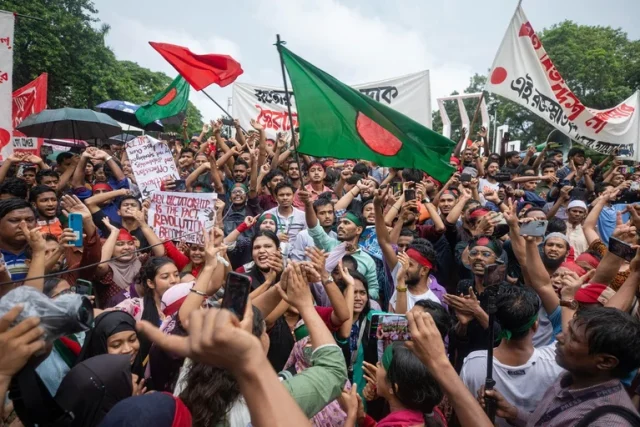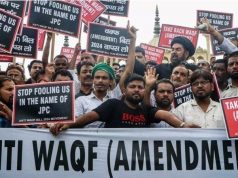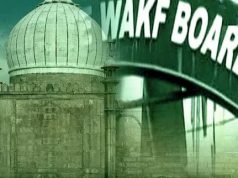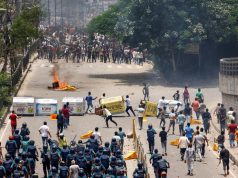Bangladesh emerged as an independent nation in 1971. Before that, it was part of Pakistan; earlier still, it had been part of India. In 1947, British India was partitioned, creating India and Pakistan, with Pakistan formed from Muslim-majority areas. The region now known as Bangladesh became East Pakistan, a predominantly Muslim area that had been part of undivided Bengal. However, as early as 1905, Lord Curzon had attempted to divide Bengal into two provinces, a move that faced strong resistance from nationalist Bengalis. Historically, Bengal had been a large region, ‘Bangala,’ encompassing Bengal, Bihar, and Odisha during the Nawabi era under figures like Nawab Siraj ud-Daulah in 1757.
By the time of partition in 1947, West Bengal was carved out as part of India, while East Bengal became East Pakistan. Significant political movements led by Hindu elites, especially from Kolkata, played a role in this division. According to historian Joya Chatterjee in her book “Bengal Divided: Hindu Communalism and Partition,” while many Bengalis opposed the 1905 partition, by 1947 they supported the division due to power dynamics. In undivided Bengal, Muslims were the majority, hence they held power. Sheila Sen’s “Muslim Politics in Bengal” explains how Hindus developed a hatred against Muslim rule during this period. In 1937, Sher-e-Banlga A.K. Fazlul Haque became Bengal’s first premier under provincial autonomy, followed by Nazimuddin and Huseyn Shaheed Suhrawardy.
If Bengal remained undivided, the Hindu elite could not reach the center of power. Thus, the Congress and Hindu Mahasabha generated public opinion in favor of dividing Bengal. After partition, leaders like Fazlul Haque, Suhrawardy, and Maulana Bhashani became prominent in East Pakistan’s politics, with Sheikh Mujibur Rahman later rising to prominence. He was a student at Maulana Azad College (then Islamia College) in Kolkata and resided at Bekar Hostel. A close confidant of Suhrawardy, Mujib had supported the Pakistan movement through the Muslim League but later formed the Awami Muslim League with Bhashani. Eventually, “Muslim” was dropped from the party’s name, making it the Awami League. Young leaders like Mujib and Tajuddin Ahmad organized the Awami League as a progressive political party.
In 1952, the Language Movement in East Pakistan marked the rise of Bengali Muslim nationalism in response to the oppressive policies of West Pakistan. By 1970, Mujib’s Awami League won a majority in Pakistan’s elections, but the delay in transferring power by General Yahya Khan intensified demands for Bangladesh. Mujib called for the independence of East Bengal. On March 25, 1971, the Pakistani army attacked Dhaka, arrested Mujib, and sent him to West Pakistan. This brutal crackdown led to a bloody war for independence.
Generals like Osmani, Ziaur Rahman, and Shafiullah of the East Pakistan Regiment declared rebellion against West Pakistan and joined the liberation war. Indian Prime Minister Indira Gandhi also sent an army to support Bangladesh. The combined efforts of freedom fighters and the Indian Army culminated in Pakistan’s defeat on December 16, 1971. During the war, the provisional government of Bangladesh, led by Tajuddin Ahmad, operated from Kolkata. After the war, Mujib returned to Dhaka in January 1972 and assumed leadership of the new Bangladesh.
However, post-war Bangladesh faced severe challenges, including famine, corruption, and accusations of nepotism against Mujib’s government. In response, Mujib established a one-party system called BAKSAL (Bangladesh Krishak Sramik Awami League), banning all political parties and allowing only four government-controlled newspapers. His authoritarian rule generated widespread discontent. On August 15, 1975, Mujib was assassinated by military officers who had fought in the liberation war, angered by the state of the country they had bled for. This assassination was initially met with widespread celebration, though relief quickly turned to instability.
Following Mujib’s death and a series of events, General Ziaur Rahman rose to power. A popular figure and a commander during the liberation war, Zia had famously declared Bangladesh’s independence over the Bengali radio station in Chittagong: “This is Swadhin Bangla Betar Kendra. I, Major Ziaur Rahman, at the directive of Bangabandhu Sheikh Mujibur Rahman, hereby declare that the independent People’s Republic of Bangladesh has been established. At his direction, I have taken the command as the temporary Head of the Republic. In the name of Sheikh Mujibur Rahman, I call upon all Bangalees to rise against the attack by the West Pakistan army. We shall fight to the last to free our motherland. By the grace of Allah, victory would be ours. Joy Bangla”.
When the people of East Bengal were facing the brutal crackdown by the Pakistani army, Ziaur Rahman’s broadcast on March 27, 1971, gave them new hope and direction. Notably, Zia declared independence twice—first without mentioning Sheikh Mujibur Rahman’s name, but shortly after, upon the advice of local leaders, he revised the statement to include Mujib’s name. Despite the initial omission, Zia’s significant role in the liberation war earned him widespread respect, and when he eventually came to power, people welcomed the change, hoping it marked the end of dictatorship.
As president, General Ziaur Rahman made efforts to restore democracy in Bangladesh. Ziaur Rahman wanted to include everyone. One of his key actions was reversing some of Mujib’s policies, such as lifting the ban on religious political parties, including Jamaat-e-Islami Bangladesh. Since then, Jamaat’s influence began to grow. Zia’s leadership, however, was cut short on May 30, 1981, when he was assassinated by members of the military in Chittagong. After his death, General Ershad seized power.
By 1990, a mass movement arose against Ershad’s regime, led by a coalition that included Sheikh Hasina, the daughter of Mujib; Khaleda Zia, Ziaur Rahman’s widow; and Jamaat. The movement successfully ousted Ershad, although he chose to remain in the country. In the general elections of 1991, Khaleda Zia’s Bangladesh Nationalist Party (BNP) formed a coalition with Jamaat-e-Islami and came to power. In 1996, Jamaat joined forces with Sheikh Hasina’s Awami League to demand a caretaker government, leading to Hasina’s victory and her first term as Prime Minister.
Jamaat-e-Islami has always played a significant role in Bangladesh’s politics, largely due to the devout nature of the country’s population. This is the land of the mystic Hazrat Shah Jalal. While Jamaat-e-Islami in Pakistan, Bangladesh, and India share much of their ideology—particularly the writings of Allama Maududi—the Bangladesh Jamaat-e-Islami has been the most successful politically. Beyond its religious focus, the party has integrated itself into the country’s social and cultural fabric, developing a distinct presence in Bangladeshi society. Maulana Delwar Hossain Sayeedi, one of Jamaat’s prominent leaders, was a ‘mass leader’ and a globally renowned speaker. He became popular through Islamic Mass Conferences and successfully integrated Jamaat’s politics among the common people, a rare feat.
After Bangladesh gained independence in 1971, the use of religion in politics was banned, which led to the dissolution of Jamaat-e-Islami. Accusations soon arose that Jamaat had opposed the liberation war. While it’s true that Jamaat did not support the division of Pakistan, this stance stemmed from their belief in the unity of the Ummah, rather than nationalism. This same position was evident during the 1947 partition of India when Jamaat did not support that division either. However, this does not mean they were against the independence movements in Bangladesh or India. Their opposition was based on an ideological position from an Islamic perspective, rather than active opposition to the struggles for independence.
Although Jamaat was labeled as complicit in the war crimes of 1971, this issue was not initially politicized. After the independence, some Jamaat leaders were released from prison under general amnesty, but the party remained banned. In 1979, Jamaat-e-Islami was allowed to re-enter politics. Their most notable success came in the 1991 elections when they won 18 parliamentary seats and helped the Bangladesh Nationalist Party (BNP) form the government. Since then, various movements have called for Jamaat to be banned and for war criminals to face trial. In 1992, a Gana Adalat (People’s Court) led by social worker Jahanara Imam sentenced Jamaat leader Ghulam Azam to death. In 1994, Ghulam Azam regained his citizenship through a court ruling, allowing Jamaat to reassert itself as a political party.
In the 2001 elections, when the BNP-led coalition came to power, Jamaat leaders Motiur Rahman Nizami and Ali Ahsan Muhammad Mujahid were appointed to ministerial positions—marking the party’s first participation in the government of independent Bangladesh. Despite ongoing debates and controversies surrounding Jamaat, the party has retained a significant support base. Accusations of crimes against humanity during the 1971 war remain a central point of contention. A list was prepared, naming 1,775 individuals accused of war crimes, including 369 Pakistani soldiers and 1,328 Bengali collaborators from groups like Razakar Al-Badr, and the Peace Committee, along with 78 Bihari agents.
In the 2008 general elections, Sheikh Hasina’s Awami League won with a promise to bring war criminals to justice. However, critics argue that her government selectively targeted Jamaat leaders for political reasons, rather than comprehensively addressing all war criminals. Prominent Jamaat figures such as Ghulam Azam, Maulana Delwar Hossain Sayeedi, Motiur Rahman Nizami, Muhammad Mujahid, and Mir Quasem Ali faced prosecution, with Nizami, Mujahid, and Quasem being executed. Ghulam Azam and Sayeedi died in prison. Many human rights activists and segments of the public questioned why only a few top Jamaat leaders were prosecuted, while those accused who had aligned with the Awami League were not held accountable. Increasingly, the public viewed Sheikh Hasina’s approach as politically motivated, deepening accusations of duplicity and authoritarian tendencies.
Following a mass uprising in August, Jamaat-e-Islami made headlines for protecting Hindu temples and contributing to restoring peace and order. This move further underscored the growing perception of Hasina’s autocratic governance, contrasting Jamaat’s actions with her leadership.
The August Uprising
On August 5, 2024, in an unprecedented turn of events, Prime Minister Sheikh Hasina secretly fled the country amidst a mass uprising. For the first time in Bangladesh’s history, a sitting Prime Minister fled in fear for her life, driven out by a popular revolution. Unlike Mujibur Rahman and Ziaur Rahman, who were killed while in power, and General Ershad, who was ousted but chose to remain in the country, Hasina chose to escape. Her departure reflected the overwhelming public anger that had been brewing against her government.
Following her downfall, statues and museums dedicated to Sheikh Mujibur Rahman, the ‘Father of the Nation,’ were destroyed. According to Meghmallar Basu, president of the Dhaka University Committee of the Progressive Student Organization Bangladesh Chhatra Union, “Breaking Mujib’s statue was part of the uprising.” However, this act wasn’t fueled by hatred for Sheikh Mujib, whom the people still admired and loved. The real target of public frustration was Hasina’s regime, which had excessively glorified her father to justify its misdeeds. People were required to sing his praises daily, as his legacy was repeatedly invoked to shield the government from criticism.
Hasina’s government used Mujib as a tool to legitimize its actions, claiming, “We are the Awami League, and I am Sheikh Mujib’s daughter, so we are the true bearers of the spirit of independence.” This narrative sidelined other key figures of the liberation war, such as Tajuddin Ahmad, the first Prime Minister of the provisional government in 1971, and Maulana Abdul Hamid Khan Bhashani, the founder of the Awami League. Hasina’s insistence on elevating only her father damaged his legacy in the eyes of the people, turning him into a symbol of her misrule, corruption, and tyranny. The people’s anger wasn’t aimed at Mujib, but at how Hasina had used his image to justify her authoritarian behavior. Unknowingly, she did severe damage to her father’s legacy. An internationally renowned leader became the victim of Hasina’s misdeeds!
There is a saying, “You can cut all the flowers but you cannot stop the coming of spring.” As the uprising unfolded, the people of Bangladesh demonstrated once again that no regime, however powerful, can suppress the will of the people. History has shown that dictators are eventually toppled by the very masses they try to control. The same fate befell Sheikh Hasina, who, like her father before her, could not withstand the collective power of the people. In August 1975, armed mutineers killed Bangabandhu Mujibur Rahman after he had established the one-party system ‘BAKSAL.’ His actions in curbing democracy led to his downfall. Similarly, neither General Ziaur Rahman nor General Ershad were spared by the people.
Bangladesh has a long history of mass uprisings. Its students and youth have always been at the forefront of movements for justice and freedom. From the Language Movement of 1952, when students shed their blood for the right to speak Bengali, to the anti-dictatorship movement in 1990 that brought down Ershad’s regime, the country’s history is rich with examples of revolution. One of the most poignant symbols of this resistance is Noor Hossain, who was martyred in the 1990 movement with “Down with dictatorship, let democracy be free” written on his chest and back. The August Uprising of 2024 is yet another chapter in this long tradition of the students’ struggle, reminding the world that when revolution is inevitable, no leader can stand in its way.
Hasina’s time was up, but like many dictators, she clung to power until the last moment. Despite widespread opposition, particularly from students, she could not relinquish her grip on the throne. Even as protests escalated, she refused to back down. In a desperate attempt to maintain control, Hasina ordered the military to use more force against the students and protesters. While the police followed her orders, the army hesitated. Their reluctance to shoot indiscriminately at civilians ultimately forced Hasina to flee the country. This escape and fall will be marked as a significant moment in the history of the subcontinent.
Public anger had been simmering for years, and it only needed a spark to ignite into a full-blown uprising. The movement began with university students demanding reforms to the quota system in government jobs. At the heart of their protest was a 30% quota reserved for the children and later, the grandchildren, of freedom fighters. This system was seen as a way to maintain a loyal voter base for the ruling Awami League. Although previous attempts to reform the quota system had been met with fierce repression, the movement that began on July 1, 2024, quickly gained momentum. On July 14, Hasina’s incendiary remark further fueled the protests. She asked, “If freedom fighters’ children don’t get reservations, will the children of Razakars (war criminals) get them?” This was a direct insult to the protesting students, branding them as the descendants of war criminals! Outraged, thousands of students at Dhaka University took to the streets, chanting, “Who are you? Who am I? Razakar, Razakar!” and “Who said, who said, Dictator, Dictator!”
This was the first time in 16 years that anyone had openly challenged Sheikh Hasina. Her government had long suppressed civil society, the media, and opposition through abductions, arrests, and intimidation. But now, students had broken the silence, and a new chapter in the quota reform movement began. On July 15, the Awami League’s student wing, the Chhatra League, was unleashed to crush the protests. Awami League General Secretary Obaidul Quader openly declared that the Chhatra League would respond to the protesters. Violence ensued, as Chhatra League members launched brutal attacks on students across universities. Female students were beaten, and many students were shot.
On July 17, the movement spread nationwide, and in Rangpur, a student named Abu Saeed from Begum Rokeya University was shot dead by police at close range. The video of his death ignited the country like a match to gunpowder. Protests erupted everywhere, with slogans like “There are many storms inside my chest, shoot at my chest!” Although the protesters couldn’t have anticipated the scale of violence that would follow, more than 200 students and civilians were killed in just a few days. Gunfire claimed the lives of children inside their homes, teenagers on rooftops, and people standing on balconies.
On July 19, a curfew was imposed, and Obaidul Quader announced that the police had been given “shoot on sight” orders. In a shocking and unprecedented move, large numbers of university students were shot and killed, leaving parents and the entire nation in tears. This massacre only fueled the anger of the public. Teachers, parents, lawyers, artists, writers, journalists, and even retired military officers began to support the movement. The protesters had nine demands, yet the government responded with mass repression. Over 10,000 people were arrested in a matter of days. The coordinators of the anti-discrimination student movement, Nahid Islam, Sarjis Alam, Hasnat Abdullah, Asif Mahmud, Abu Bakar Mujumdar, and Nusrat Tabassum were taken and detained at the Detective Branch (DB) office of the Dhaka Metropolitan Police. They were forced to record video messages withdrawing the movement. But public pressure, fueled by hunger strikes and relentless demonstrations, forced the government to release them.
From Friday, August 2, Bangladesh was engulfed in a wave of renewed protests. After Friday prayers, angry crowds of students, teachers, and the general public gathered in major cities and universities across the country. The arrests of movement leaders had sparked this surge of resistance, with tens of thousands demanding their release. Dhaka’s Shaheed Minar and Shahbagh Square became the epicenters of protest. Despite the rain—sometimes light, sometimes heavy—the air was filled with passionate slogans. Processions streamed into Dhaka, seemingly endless, and the roads leading to the central Shaheed Minar were packed with protesters, stretching for 8 kilometers. The rebellion had turned into a sea of people.
Amidst this rising tide, the Bangladesh army refused to stand against the citizens. In a last-ditch effort, Sheikh Hasina deployed her political forces, but the movement only intensified on Saturday. From Shaheed Minar, protesters voiced a singular demand: Hasina must resign. The weight of so many deaths demanded accountability. “One demand, one voice—Sheikh Hasina must resign!” became the cry that reverberated across the nation. What had started as a movement for quota reform had now transformed into a demand for the fall of Hasina’s government. People from every walk of life—students, teachers, artists, laborers, even rickshaw pullers—joined the movement, united in their call for change. From Dhaka to Barisal, from Rajshahi to Chittagong, there was only one chant: Hasina Must Resign.
Though Hasina expressed a willingness to engage in dialogue, the protesters rejected her offer outright. On Sunday, the movement’s coordinator, Nahid Islam, called for a total non-cooperation movement nationwide, demanding the resignation of Sheikh Hasina and her entire cabinet. In response, the Awami League prepared for a violent confrontation. On August 4, leaders and activists from the Awami League, Jubo League, Chhatra League, and Secchasebak League launched attacks on protesters across the country. Some carried firearms, while others wielded traditional weapons. Clashes left at least 114 people dead, but the Awami League forces could not hold their ground for long against the determined resistance of students and the public.
That same day, the anti-discrimination student movement called for a ‘Long March to Dhaka.’ As Sunday unfolded, it became increasingly clear that the government’s reliance on guns and force was failing. A curfew was imposed by Monday, but in a major turning point, the army chief issued a statement: “The Bangladesh Army would stand by the people.” This declaration had a profound impact. From Sunday night onward, a massive influx of people poured into Dhaka. By noon on Monday, the government’s grip on power was visibly slipping.
At 2:30 PM, Sheikh Hasina, who had confidently declared just days earlier on August 1 that neither she nor the Awami League would ever flee, was forced to leave the country with the help of the military. In the end, Hasina’s downfall came because she lacked the mandate of the people. Had she come to power through a legitimate, democratic process, this collapse might have been avoided.
Sheikh Hasina, leader of the Awami League, was sworn in for her fourth consecutive term as Prime Minister on January 11, 2024. Her political journey began with her election as Prime Minister in 1996. When the BNP won the 2001 elections, Hasina became the opposition leader. However, under a caretaker government, she reclaimed the position in 2008. Five years later, in 2014, she conducted a highly criticized election in which 153 MPs were elected unopposed, as opposition parties boycotted the polls. In 2018, her government faced backlash after widespread allegations of ballot-stuffing before election day, leading the 2018 polls to be dubbed a ‘night vote’ or ‘shadow election.’ Despite the controversies, she remained in power.
In 2024, another election boycott by the opposition led Hasina to retain her position through a process labeled by critics as a ‘dummy election,’ where independent candidates were mostly from her party. Throughout her tenure, Hasina’s government faced accusations ranging from suppression of voting rights and free speech to human rights violations, corruption, money laundering, subjecting the country to capitalist exploitation, destroying state institutions, allowing banks to be looted under the guise of loans, and fostering extreme income inequality. She used the Rapid Action Battalion (RAB) to suppress dissent, leading to U.S. sanctions against the force. A notorious detention center known as ‘Aynaghar’ (Mirror House) was established under her rule, likened by some to Nazi concentration camps.
Despite this, Hasina pointed to infrastructure development and economic growth to defend her leadership. However, toward the end of her rule, the country’s economy faltered. Foreign currency reserves dwindled, non-performing loans rose, and inflation made life difficult for the poor. When confronted with these issues, Hasina and her ministers often responded dismissively, with some even absurdly claiming Bangladesh had become like Singapore.
July 2024 marked a tragic chapter in the country’s history, with a death toll unseen in past movements. Students once again led the charge, with significant participation from women. The protests unfolded not only on the streets but also online. With traditional media under government control, students turned to Facebook and Twitter to share their stories and organize, with social media becoming a battleground for ideological resistance. Images of police shootings, grief, and protests circulated widely, often set to songs of the liberation war and patriotic anthems. Graffiti and new slogans symbolized the movement’s spirit.
At the forefront of this uprising was Generation Z, tech-savvy and determined, who fought their battle in their own way. The internet was repeatedly shut down to stop them, but ‘spring’ could not be stopped. The flower buds have arrived. It is the responsibility of all the students to turn them into fragrant flowers. The task of building the future Bangladesh, surpassing various conspiracy theories and blueprints of seasoned villains, is much tougher than the revolution itself.






